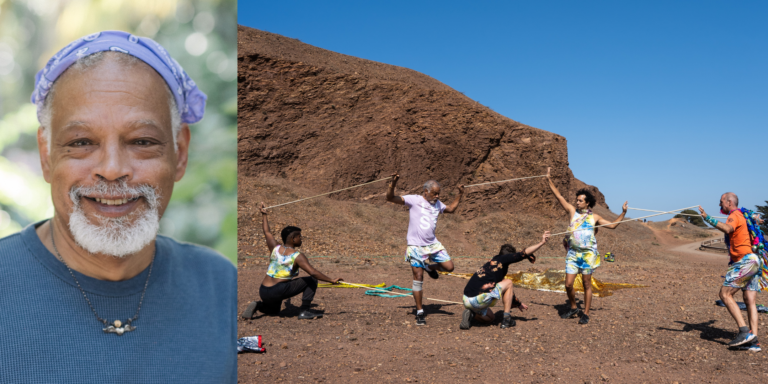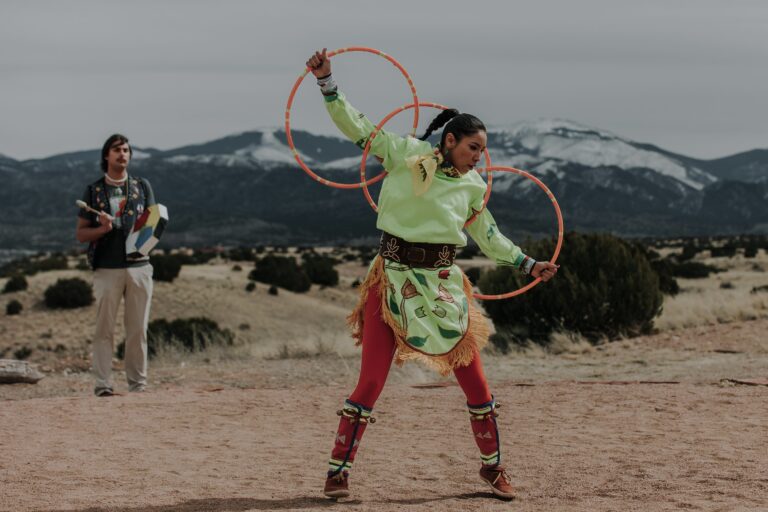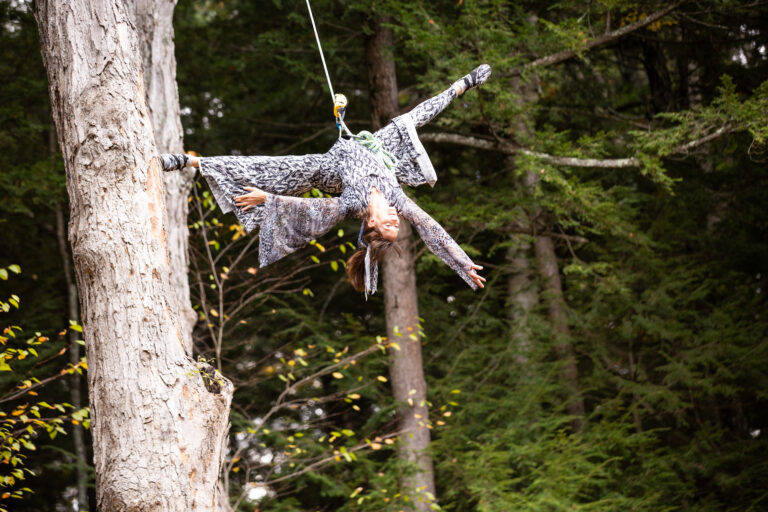
Katherine Dunham, this year’s Dance Teacher Lifetime Achievement Award recipient, brought the dance traditions of Africa and the Caribbean to North America and Europe—founding her own dance companies and schools, creating her own technique and changing dance history forever along the way.
Katherine Dunham celebrated her 95th birthday on June 22, but today, just a week later, she is thinking about 44 pounds of luggage. In three more days she will be on a plane headed to Cuba to teach and lecture, and the maximum baggage weight seems insufficient. Then again, Dunham is a woman who not only performed and taught globally and founded several dance companies and schools, but also created her own dance technique—one that is taught in schools and studios around the world and that has profoundly influenced a broad range of performers, from Alvin Ailey and Talley Beatty to Janet Collins and Eartha Kitt. With or without luggage, there’s no doubt that she will be plenty inspiring.
By any measure, Dunham is one of the world’s greatest dance innovators. Her technique, with its emphasis on Caribbean and African rhythms, expanded the concert dance vocabulary. As an anthropologist who did extensive fieldwork in the Caribbean, she also opened Western eyes to the richness of integration, in dance as in life.
In fact, African and Caribbean rhythms and dance styles are so pervasive today that it’s hard to imagine that Dunham once traveled the world to import them. Long before Cirque du Soleil was a household name, she auditioned hundreds of dancers, musicians and singers during a talent safari through Africa in preparation for her 1962 show Bamboche. The production ended up featuring 14 dancers from the royal court of Morocco who had never performed outside the court of King Hassan II. Dunham’s diplomatic conversations with the King sealed their appearance.
Whether taking on the role of dancer, choreographer, director, researcher, writer or teacher, Dunham has always been a model of social and political consciousness. During World War II, when she toured the U.S. with her company, she spoke out against segregation, telling one audience in Louisville, Kentucky: “I must protest because I have discovered that your management will not allow people like you to sit next to people like us. I hope that time and the unhappiness of this war for tolerance and democracy, which I am sure we will win, will change some of these things—perhaps then we can return. Until then, God bless you, for you will need it.” The patience, curiosity and respect she brought to her study of different cultures set a high standard for today’s dancers, scholars and diplomats.
Asked to choose a highlight of the past nine decades, Dunham demurs that it would be very difficult. “I could think of one everyday and never run out!” she exclaims. Speaking eloquently about her dancing and teaching while sitting in her apartment on New York City’s Upper West Side, Dunham exhibits the same vibrancy that she did in the 1930s and ’40s, when she toured nationally and internationally with her company and appeared in shows such as Cabin in the Sky and films such as Stormy Weather.
Born in Chicago, Dunham began studying anthropology at the University of Chicago. While there, she studied dance with such teachers as Adolph Bolm, Vera Mirova, Ludmilla Speranzeva and Mark Turbyfill. During this time, she also formed her first dance company, Ballet Negre, with help from Turbyfill and Ruth Page.
In 1935, she was awarded a grant from the Rosenwald Foundation to conduct anthropological fieldwork in the West Indies. “Melville Herskovits [a professor at Northwestern University] wanted me to continue some of the things that he had begun and to try to codify things he saw developing in me, such as my curiosity about people,” Dunham says. “My need to participate in the daily life of the people in order to learn one facet of their culture was something he believed in.” Among her other mentors she counts Erich Fromm, a psychoanalyst, and Robert Redfield, a UC anthropology professor.
 Katherine Dunham in rehearsal with Vanoye Aikens (Mexico, 1955)
Katherine Dunham in rehearsal with Vanoye Aikens (Mexico, 1955)
Dunham explains that she chose the West Indies because “Africa was distant [and] I was a lone woman. It was not customary for a young woman to go to Africa by herself.” In addition, she was curious about acculturation, or the process by which the customs of one culture are modified as a result of contact with another culture. “I was, myself, of a mixed culture,” she says, referring to the ancestry of her father, Albert, who was African-American and her mother, Fanny June Dunham, who was French Canadian and Native American. “I knew there were things I had to know about both cultures—American and African—in order to understand what happened when they met and were absorbed into one another.”
During this fieldwork, which lasted from 1935 to 1936, Dunham studied the dance forms of Jamaica, Martinique, Trinidad and Haiti. In these countries, slave owners’ practice of breaking up families and tribes to prevent rebellion was not as common as in the U.S., so the ritual and social dances and music of Africa were better preserved and thus available to Dunham to explore. Although her main interest was dance, she discovered much more. “If you live among people, you become interested in what they eat, and their religion, and ways of playing, having fun, mourning, courtship, all those things,” she says. “They fall on you whether you want them to or not.”
Upon returning to the U.S., she began presenting pieces inspired by the dances she had seen and soon formed a new dance company, The Katherine Dunham Company. One of her most famous works, L’Ag’Ya, melded elements of ballet and modern with Cuban, Martinican and Brazilian dance forms. It also featured costumes by theatrical designer John Pratt, whom she later married and with whom she collaborated until his death in 1986.
In 1940, Dunham performed her landmark show, Tropics and Le Jazz Hot: From Haiti to Harlem, in NYC. Originally scheduled for a one-night engagement, it ended up running for three months. At the time, American audiences were not familiar with the hip and shoulder isolations or undulating torsos that Dunham and her dancers made so expressive, yet they welcomed and applauded the brand-new style. That year, The New York Times wrote: “[Dunham’s] performance with her group at the Windsor Theatre may very well become a historic occasion, for certainly never before in all the efforts of recent years to establish the Negro dance as a serious medium has there ever been so convincing and authoritative an approach…. It is because she has showed herself to have both the objective quality of the student and the natural instinct of the artist that she has done such a truly important job.”
The success of Tropics and Le Jazz Hot launched Dunham’s career on Broadway, in Hollywood and beyond. 1940 also saw Dunham working with George Balanchine on the show Cabin in the Sky. “I learned a lot from Balanchine,” Dunham recalls. “He was very sensible about things. He’d come to me and say, ‘I don’t know anything about this,’ and then we’d put something together. We worked together very well.” She jokes: “He had the title of choreographer. If he hadn’t been Balanchine, I would have been very jealous.”
Unlike ballet, which was imported from Europe and emphasized a dancer’s weight being lifted, Dunham’s style of movement kept dancers in contact with the earth. Each part of the body—hips, shoulders, arms and back—was isolated and played against one another in contrasting rhythms. “Chest rolls were accomplished by the gentle releasing of the spine,” remembers Arthur Wright, a student of Dunham’s in the late 1940s, writing in the June 1983 issue of Attitude magazine.
As Dunham continued to create dances, she gradually developed and codified a technique, although she didn’t set out to do so. “I just knew that I was not totally satisfied with classical ballet or modern or one or another folk dance,” she says. “I knew that there was something missing, and what I felt was missing was a kind of understanding of one’s body, along with the movement. I think that is terribly important.”
In 1945, Dunham opened what became her largest school, eventually called the Katherine Dunham School of Cultural Arts, in NYC with only 12 students. (Lee Shubert, the renowned Broadway theater owner, donated the studio space.) Ten months later, she had 420. A young Marlon Brando was just one of the many dancers and actors who attended classes there before it closed in 1955.
Throughout her career, Dunham’s teaching was grounded in a holistic way of thought. At the Katherine Dunham School, she held classes not only in dance and choreography but also in pure exercise, French and Spanish language, astronomy and more. “We had courses in generalized philosophy, a way to approach living that would help students understand our holistic approach,” she recalls. “We had a few lectures or a course in introductory philosophy. A number of students followed my particular interest in ancient Egyptian social life. We can extract a good deal of information from their drawings about their movement and dances, singly and in groups. Archeology is like anthropology, except you learn about people from their artifacts, remains and art.” Pratt also gave lectures on the materials and designs of particular ballets or cultures.
She often imported musicians to accompany the movement classes. “We had to have accompaniment that was rhythmic. Percussion was very important,” she says. “So sometimes I’d bring drummers back with me from wherever I had been. Some of my most wonderful drummers were from Cuba, Nigeria and Senegal. Or I’d find them in the groups in Harlem.”
In the 1960s, Dunham became the first African-American to choreograph for the Metropolitan Opera when she created the dances for Aida. A few years later, she moved to Senegal for a year and trained dancers in the Senegalese National Ballet. The U.S. State Department named her the U.S. representative to the First World Festival of Negro Arts in Dakar, Senegal, and she also served as a cultural advisor to the country’s president, Leopold Senghor.
Moving back to the U.S., Dunham settled in East St. Louis, Illinois, and, in 1967, received funding from the Office of Economic Operations in Washington, DC, to open a cultural arts center in a neglected neighborhood. She was attracted to East St. Louis because it reminded her of towns where she had lived, such as Port-au-Prince, Haiti, and Dakar, Senegal. This school was called the Performing Arts Training Center. Today, the Katherine Dunham Centers for Arts and Humanities, located in East St. Louis, maintains the Katherine Dunham Dynamic Museum and annually runs the Dunham Technique Seminar in St. Louis, Missouri. The Technique Seminar celebrated its 20th anniversary this year and offered classes in and discussions about Dunham’s technique and repertory.
For Dunham, teaching is a matter of instinct: “If I knew something and knew it could help somebody else, I had to impart it. I’ve always been that way, even though it sometimes got me in trouble when I would speak out of turn!” She considers the most important element in teaching dance to be creating a personal relationship with students. “Anyone can talk, demonstrate or show videos, but you must have a real personal interest in the students and what they’re doing, what they’re thinking,” she stresses. “And allow them to express what they feel. Always, always keeping a warm interrelationship. That’s what makes a student want to go on.” She credits some of her teachers, including Mirova and Speranzeva, with giving her this motivation.
Dunham’s own teaching was amazingly prescient. The holistic approach to dance that she always championed is now prevalent in the dance world, while some dance schools in the U.S. and Europe even require that students take anthropology. As for her own students, she says that they “have a firmly established body, mind and spirit approach” and that they “know that movement is worthless unless it has all three of these elements behind it.” In fact, she takes this philosophy as a kind of life motto: “If you just simply exist, you never learn. If you live, you learn without trying to learn.” DT
Kate Mattingly is a freelance writer based in New York City.
Photos (from top) by Eduardo Patino; Katherine Dunham Collection/Missouri Historical Society, St. Louis, permission granted by Katherine Dunham




